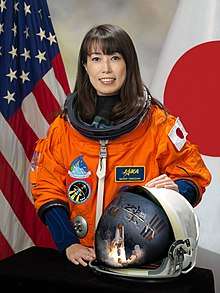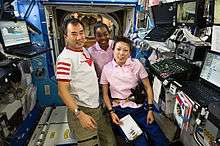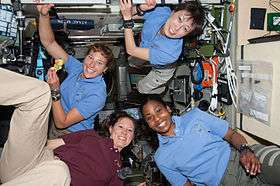Naoko Yamazaki
Naoko Yamazaki (山崎 直子, Yamazaki Naoko, born December 27, 1970) is a former Japanese astronaut at JAXA, and the second Japanese woman to fly in space.[2][3][4] The first was Chiaki Mukai.[3]
Naoko Yamazaki | |
|---|---|
 | |
| Born | December 27, 1970 Matsudo, Chiba, Japan |
| Status | Retired |
| Nationality | Japanese |
| Occupation | Engineer, Researcher |
| Space career | |
| NASDA/JAXA Astronaut | |
Time in space | 15 days, 2 hours, 47 minutes[1] |
| Selection | 1999 NASDA Group |
| Missions | STS-131 |
Mission insignia | |
| Retirement | August 31, 2011 |
Early life
Yamazaki was born Naoko Sumino in Matsudo City. She spent two years of her childhood in Sapporo.[5] After graduating from Ochanomizu University Senior High School in 1989, Yamazaki earned a Bachelor of Science degree with a major in Aerospace Engineering from the University of Tokyo in 1993 and a Master of Science degree with a major in Aerospace Engineering in 1996.[2][6]
JAXA career
Yamazaki joined the National Space Development Agency of Japan (NASDA) in 1996 and was part of the development team for the system integration of the Japanese Experiment Module (JEM). She also worked on the JEM failure analysis and creating initial operation procedures. From June 1998 to March 2000, she was part of the ISS Centrifuge team (life science experiment facility) conducting conceptual framework and preliminary design.[6]
Yamazaki was selected as an astronaut candidate in February 1999 by the National Space Development Agency of Japan (NASDA, now JAXA), attended the ISS Astronaut Basic Training program beginning in April 1999, and was certified as an astronaut in September 2001.[6] Since 2001, Yamazaki has participated in ISS Advanced Training and supported the development of the hardware and operation of the Japanese Experiment Module.[2][6] In May 2004, Yamazaki completed Soyuz-TMA Flight Engineer training at the Yuri Gagarin Cosmonauts Training Center in Star City, Russia.[2]
NASA experience

In June 2004, Yamazaki arrived at the Johnson Space Center in Houston, Texas to begin Astronaut Candidate Training school,[2] where she was assigned to the Astronaut Office Robotics Branch.[2] She was selected as a NASA mission specialist in 2006.[7]
In November 2008, JAXA announced that Yamazaki would become the second Japanese woman to fly in space on STS-131, which launched on 5 April 2010.[3][4][8] Since the space shuttle retired the following year in 2011, she was also the last Japanese astronaut to ever fly the space shuttle.[9]
On April 5, 2010 Yamazaki entered space on the shuttle Discovery as part of mission STS-131. She returned to Earth on April 20, 2010.[10]

Yamazaki retired from JAXA on August 31, 2011.
Post JAXA
After returning to Earth, after spending a total of 15.12 days in space,[12] Yamazaki continued her studies and research University of Tokyo since December 2010.[6]
Since 2011, Yamazaki has been involved with promoting STEM activities as well as being a member of the Japanese government Space Policy Committee [13] [14]
In July 2018, Yamazaki co-founded the Space Port Japan Association, which is an organization to support efforts to open spaceports in Japan through collaboration with companies, groups and government institutions.[15] She is an adviser to the Young Astronaut Club, and Chairman of the Women in Aerospace program of the Japan Rocket Society.[7]
As of July 2019, Yamazaki was a PhD student at the Intelligent Space Systems Lab in the University of Tokyo.[16]
Personal life
Yamazaki was married to Taichi Yamazaki and the couple have two children; they were divorced in February 2012. She enjoys scuba diving, snow skiing, flying and music.[2]
In 2007, Yamazaki provided the voice as herself in episode 7 of the anime Rocket Girls.
See also
- Women in space
- List of female astronauts
References
- "Spacefacts biography of Naoko Yamazaki". spacefacts.de.
- NASA (January 2008). "Naoko Yamazaki". NASA. Retrieved 2008-11-18.
- Reuters (November 11, 2008). "Astronaut set to become Japan's first mum in space". Reuters UK. Retrieved November 18, 2008.
- JAXA (November 11, 2008). "Naoko Yamazaki to become second Japanese female astronaut to fly to space". Japan Aerospace Exploration Agency. Archived from the original on December 13, 2009. Retrieved 2008-11-18.
- NASA (March 8, 2010). "Preflight Interview: Naoko Yamazaki, Mission Specialist". Retrieved March 11, 2010.
- JAXA (October 6, 2011). "Naoko Yamazaki". Japanese Aerospace Exploration Agency. Retrieved December 1, 2019.
- FernandoRestoyRodriguez (2019-02-07). "Women and Girls in Science Podcast Series: Astronaut Naoko Yamazaki". academicimpact.un.org. Retrieved 2020-07-12.
- NASA (2008). "Consolidated Launch Manifest". NASA. Retrieved October 25, 2008.
- Malik, Tariq "NASA Delays Space Shuttle Program's End to 2011". Space.com, July 1, 2010
- Harwood, William. "Shuttle Lifts Off for Space Station", The New York Times, New York City, April 5, 2010. Retrieved on 2010-04-05.
- "Four Women will Fly in Space for the First Time in the History". Russian Federal Space Agency. 3 April 2010. Archived from the original on 8 April 2010. Retrieved 3 April 2010.
- "Yamazaki". www.astronautix.com. Retrieved 2020-07-12.
- Rebecca Tan (January 11, 2017). "Asia's Scientific Trailblazers: Naoko Yamazaki". Asian Scientist. Retrieved December 1, 2019.
- "Asia's Scientific Trailblazers: Naoko Yamazaki". Asian Scientist Magazine | Science, technology and medical news updates from Asia. 2017-01-11. Retrieved 2020-07-12.
- "Former astronaut Naoko Yamazaki hopeful for commercial space travel". January 1, 2019. Retrieved December 1, 2019.
- "To the moon - Researchers reflect on the 50th anniversary of the Apollo 11 moon landing: Astronaut Naoko Yamazaki". University of Tokyo. July 20, 2019. Retrieved December 1, 2019.
This article incorporates text from OpenHistory.
External links
| Wikimedia Commons has media related to Naoko Yamazaki. |
- JAXA biography
- Naoko Yamazaki on Twitter

- Spacefacts biography of Naoko Yamazaki
- JAXA TODAY No. 2
- Seeing Earth from Space Naoko Yamazaki at TEDxHaneda, August 2015